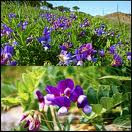:::::::::::::::::::::::::::::::::::::::::::::::::::::::::::::::::::::::::::::::::::::::::::::::::::::
Beach Pea (hama-endoo)
***** Location: Japan
***** Season: Early Summer
***** Category: Plant
*****************************
Explanation
Hama-endoo, ハマエンドウ 浜豌豆
Beach pea
Lathyrus japonicus

Grows in the sandy beaches of Japan. Hight about 20 to 60 cm. Flowers about 3 cm big.
:::::::::::::::::::::::::::::::::::::::::::::::::::::::::::::::::::::::::::::::::::::::::::::::::::::
Lathyrus japonicus (common names Sea Pea, Beach Pea, Circumpolar Pea, Sea Vetchling) is a legume native to temperate coastal areas of Asia, Europe, North and South America.
It is a herbaceous perennial plant growing trailing stems to 50-80 cm long, typically on sand and gravel storm beaches. The leaves are waxy glaucous green, 5-10 cm long, pinnate, with 2-5 pairs of leaflets, the terminal leaflet usually replaced by a twining tendril. The flowers are 14-22 mm broad, with a dark purple standard petal and paler purple wing and keel petals; they are produced in racemes of 2-7 together.
The unusually extensive native range is explained by the ability of the seeds to remain viable while floating in sea water for up to 5 years, enabling the seeds to drift nearly worldwide. Germination occurs when the hard outer seed coat is abraded by waves on sand and gravel.
The pods can be eaten but like many members of the genus Lathyrus they contain β-oxalyl-L-α,β-diaminopropionic acid, which can cause paralysis called lathyrism. The leaves of the plant are used in Chinese traditional medicine.
© More in the WIKIPEDIA !
*****************************
Worldwide use
Strand-Platterbse
:::::::::::::::::::::::::::::::::::::::::::::::::::::::::::::::::::::::::::::::::::::::::::::::::::::
North America
Connecticut Wildflowers
• Family: Pea (Fabaceae)
• Habitat: sandy shores
• Height: 1-2 feet
• Flower size: 3/4 inch wide
• Flower color: pink to purple
• Flowering time: June to August
• Origin: native
http://www.ct-botanical-society.org/galleries/lathyrusjapo.html
Synonyms: sea pea, Lathyrus maritimus
Lathyrus japonicus
Grows in open, sandy area. Attracts bees, wasps, and butterflies. Blooms late spring to summer.
It, like pea plants, is a runner (vine). It grows above the tideline flourishing amongst the rounded stones and sand. Any one familiar with the garden pea plant will immediately recognize the flower of the beach pea. It’s flower is of a rather complicated arrangement and colored pink-lavender; it is quite showy. And, yes, little pea pods will show up where the flowers have been. It is thought that the herbage of the beach pea contains a poisonous alkaloid.
Carole MacRury
*****************************
Things found on the way
Nice picture page with flowers that bloom
on the Japanese sea shores.
http://www.mitomori.co.jp/hanazukan/hanazukan2.12.html
*****************************
HAIKU
浜豌豆網繕ふに網に座し
beach peas -
repairing the nets while
sitting on nets
蒔田 孝子
http://www.ginet.or.jp/haiku/taikai/00taikai-1.htm
xxxxxxxxxxxxxxxxxxxxxxxxxxxxx
seaside retreat -
an old tent surrounded
by beach pea …
Carole MacRury
*****************************
Related words
***** . Beach and Shore (hama)
[ . BACK to WORLDKIGO . TOP . ]
:::::::::::::::::::::::::::::::::::::::::::::::::::::::::::::::::::::::::::::::::::::::::::::::::::::








No comments:
Post a Comment